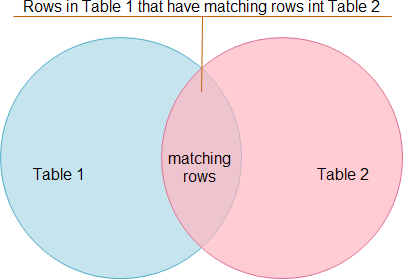W inner of Best BI Software for SQL. Get the Most out of Your Data. Watch the Free Tableau Video Demo! Move Forward With Confidence. Connecting With The Data Community.
SQL HOME SQL Intro SQL Syntax SQL Select SQL Select Distinct SQL Where SQL An Or, Not SQL Order By SQL Insert Into SQL Null Values SQL Update SQL Delete SQL Select Top SQL Min and Max SQL Count, Avg, Sum SQL Like SQL Wildcards SQL In SQL Between SQL Aliases SQL Joins SQL Inner Join SQL Left Join SQL Right Join SQL Full Join SQL Self Join SQL. SQL provides many kinds of joins such as inner join , left join , right join , full outer join , etc. This tutorial focuses on the inner join. The inner join clause links two (or more) tables by a relationship between two columns. You can also use LEFT OUTER JOIN or RIGHT OUTER JOIN , in which case the word OUTER is optional, or you can specify CROSS JOIN.
There are four basic types of SQL joins: inner , left, right, and full. INNER JOIN ON vs WHERE clause - Stack. An inner join of A and B gives the result of A intersect B, i. In SQL, a join is used to compare and combine — literally join — and return specific rows of data from two or more tables in a database. Venn diagram intersection. In this query, the inner join clause matches rows from both products and categories tables.

If a row in the products table has the same value in the category_id column as a row in the categories table, the query combines the values of columns specified in the select list into a new row and includes that new row in the result set. When to use inner join? SQL provides several types of joins such as inner join , outer joins ( left outer join or left join , right outer join or right join , and full outer join ) and self join. What is a database inner join? The difference between inner join and outer join is as follow: Inner join is a join that combined tables based on matching tuples, whereas outer join is a join that combined table based on both matched and unmatched tuple.
APPLIES TO: SQL Server Azure SQL Database Azure Synapse Analytics ( SQL DW) Parallel Data Warehouse SQL Server performs sort, intersect, union, and difference operations using in-memory sorting and hash join technology. This keyword will create the result-set by combining all rows from both the tables where the condition satisfies i. In this puzzle, we’re going to learn how to rewrite a subquery using inner joins. Knowing about a subquery versus inner join can help you with interview questions and performance issues. Though subqueries have unique abilities, there are times when it is better to use other SQL constructs such. Besides the ON clause, it is possible to use the USING clause to specify which columns to test for equality when joining tables.

The SQL Inner Join is is one of the SQL Join Type which returns the records (or rows) present in both tables If there is at least one match between columns. Or we can Simply say, Sql Server Inner Join returns the records (or rows) present in both tables as long as the Condition after the ON. SalesOrderID FROM Production. This is the most common type of join.
Inner joins combine records from two tables whenever there are matching values in a field common to both tables. A SQL JOIN combines records from two tables. A JOIN locates related column values in the two tables.
A query can contain zero, one, or multiple JOIN operations. Both inner and outer joins are used to combine rows from two or more tables into a single result. The join condition specifies how columns from each table are matched to one another.
PROC SQL joins do not require that common variable have the same name in the data sets you are joining, while you need to have common variable name listed in BY option when using MERGE statement. The scope of expressions in the ON clause includes the current tables and any tables in outer query blocks to the current SELECT. For an inner join , “Handle matching rows” returns the combined data to the calling operator. On the next call, the “Next?
Inner join creates a new result table by combining column values of two tables (A and B) based upon the join -predicate.
Nincsenek megjegyzések:
Megjegyzés küldése
Megjegyzés: Megjegyzéseket csak a blog tagjai írhatnak a blogba.